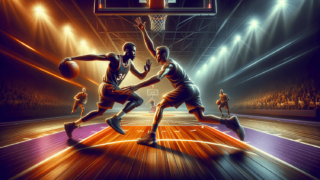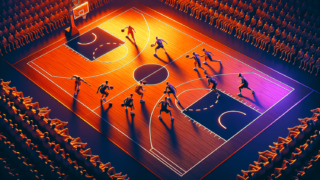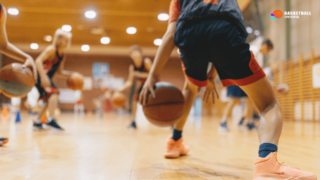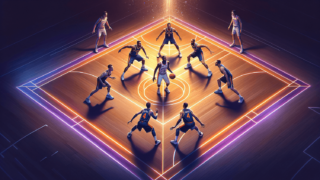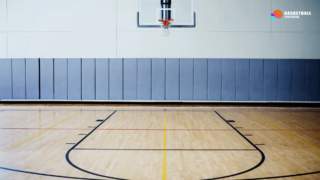
Welcome to the fascinating world of basketball court painting, where creativity meets precision and technique! Whether you are a die-hard basketball aficionado or simply a curious learner, understanding how basketball courts get their iconic designs can be truly engaging. In this blog post, we will unravel the artistry and science behind crafting the colorful playing surfaces, where legends leap and enthusiasts enjoy every dribble, fadeaway, and slam dunk. So, lace up your sneakers and get ready to delve into the captivating process of painting basketball courts.
How Do They Paint Basketball Courts?
Painting basketball courts involves several steps, including surface preparation, layout and masking, paint application, and line marking. First, the surface is thoroughly cleaned, and any imperfections are fixed to ensure proper adhesion of the paint. Next, the court layout is designed, and masking is applied to protect specific areas from paint. After that, the paint is applied using rollers, brushes, or spray equipment, depending on the desired finish. Finally, once the paint is dry, lines and markings are drawn to create a regulation basketball court.
Preparing the Court Surface
Before any paint is applied, the basketball court surface must be properly prepared. This includes removing any dirt, debris, and foreign materials that could interfere with the paint. Depending on the underlying surface material (wood, concrete, or asphalt), different methods are employed to ensure optimal results. For wood surfaces, sanding and dust removal are essential steps; for concrete, power washing and crack repair may be necessary; and for asphalt, pressure washing and filling in low spots with leveling compounds are common procedures. Regardless of the surface, basketball court painting begins with diligent surface preparation.
Sanding and Dust Removal
If working with a wood surface, like that of an indoor basketball court gymnasium, sanding is a crucial step. By lightly sanding the court, you create small grooves and crevices that improve the adhesion and durability of the paint. Following this process, thoroughly vacuum and dust the floor to remove any remaining residue. Always remember that a clean surface is vital for achieving the desired results.
Power Washing, Crack Repair, and Leveling
Outdoor basketball courts constructed from concrete or asphalt require specific surface preparation techniques. Begin by power washing the court, which helps blast away dirt, debris, and contaminants. If there are any cracks, it is important to repair them with crack filler or cementitious patching material before painting. For low spots or dips, use a leveling compound or additional patch material to create an even surface. Once these steps are completed, ensure the court is clean, dry, and free of loose particles.
Designing the Court Layout and Masking
After preparing the surface, the next step is designing the basketball court layout. This involves measuring and plotting the court dimensions, as well as planning the graphics, logos, and other design elements. Whether you’re creating a regulation-style court or something more customized, it is essential to ensure that all lines and markings are accurately placed.
Measuring and Plotting Court Dimensions
Follow official guidelines and dimensions when laying out your basketball court. Use a measuring wheel, a measuring tape, a plumb line, and a chalk line to map out the boundaries, free throw lines, lanes, and other key court markings. Pay close attention to accuracy; remember, a precise layout is the foundation of a visually stunning and functional basketball court.
Determining Graphics, Logos, and Colors
Beyond the regulation lines and markings, you may wish to include additional graphics, logo designs, and vibrant color schemes. Keep in mind that paint thickness, color contrast, and the overall appearance of your court surface affect the finished product. Create a plan for your design and follow it closely while painting to guarantee a professional-quality result. Additionally, consider the use of stencil kits or custom-made stencils for complex graphics and logos.
Masking and Protection
Masking is essential for avoiding unwanted paint applications or color bleeding during the painting process. Using masking tape, plastic sheeting, or protective films, take the time to cover areas not meant to receive paint. Proper masking ensures clean, sharp lines and a polished final appearance.
Paint Application Techniques
There are three primary methods for applying paint to basketball courts: rolling, brushing, and spraying. Each technique has its advantages and disadvantages, so understanding the best method for your court is crucial.
Rolling
Rolling paint onto a basketball court can provide a smooth, even finish. Rollers are available in a variety of widths, making it easy to cover large areas quickly and efficiently. It is essential to choose a good-quality paint roller and the correct nap thickness for your chosen paint. Begin by applying paint to the surface, distributing it evenly with the roller, and working your way across the entire surface in a methodical manner. Adjust pressure and paint distribution to achieve a consistent finish. While rolling is time-consuming compared to spraying, it provides better control and precision.
Brushing
Brushing is ideal for smaller areas or for painting intricate graphics and logos on the basketball court surface. Quality paintbrushes with different bristle types are available to suit the paint you have chosen. The key to successful brush application is using the proper brush techniques, applying the right amount of paint, and maintaining a steady hand for clean, crisp lines.
Spraying
For those who prefer a faster, more uniform paint application, airless spray equipment can be employed. These machines spray a steady, even coat of paint, making short work of your basketball court painting project. Keep in mind, however, that you must properly mask and protect the surrounding areas from overspray. Additionally, spraying may require more attention to paint thickness consistency and court surface preparation.
Marking the Lines and Logos
After the paint is dry, the final step in basketball court painting is marking the lines and logos. This is where precision and attention to detail are essential. Ensure that your layout, lines, and graphics are both visually appealing and accurate to official basketball court dimensions.
Applying Lines and Graphics
There are several options for applying lines and graphics to your basketball court — you can paint, tape, or adhere them by using thermoplastic paint solutions. No matter your choice, ensure that the methods and materials are compatible with your court surface and the paint you have applied. Achieving clean, precise lines and graphics can make or break the appearance of the finished court. As you begin marking out the court, use tape measures, chalk lines, and templates to ensure accuracy and precision.
Using Stencils and Templates
When painting logos, graphics, and other intricate design elements on your basketball court, consider using custom-made stencils or templates. These tools can help you achieve a professional-quality appearance, with clean lines and well-defined shapes. There are commercial stencil kits available for typical basketball court elements, or you can create your own using a large-format printer and design software.
Maintaining Your Painted Basketball Court
To extend the longevity and appearance of your freshly painted basketball court, proper maintenance and care are crucial. Implement a regular cleaning routine to remove dirt, debris, and any other materials that could damage the court’s surface. In addition to cleaning, regular inspections are vital to detect and repair any damage, such as cracks or chipped paint areas. By being proactive, you can ensure that your basketball court remains a beautiful and safe space for years to come.
Cleaning and Debris Removal
Keeping your basketball court clean is paramount for avoiding damage to the paint and surface. Sweeping or vacuuming hardwood courts regularly will prevent dirt, dust, and debris from wearing down the paint. For outdoor concrete or asphalt courts, periodic pressure washing can help remove dirt and stains that accumulate over time. Always follow the manufacturer’s recommendations for cleaning your specific court surface and paint type.
Inspection and Remediation
Regularly inspecting your basketball court for signs of wear or damage can help you address issues before they escalate. Look for cracks, chipped paint, or other areas of concern, and remediate them as soon as possible to extend the life of your court. Repair cracks and fill low spots with appropriate filler or leveling compound, and repaint chipped or worn-out areas with matching paint. By staying vigilant in your court maintenance, you can create an inviting and functional basketball space that lasts for years.
Choosing the Right Paint for Your Basketball Court
Selecting the appropriate paint for your basketball court can make a significant difference in the finished product’s appearance and durability. The type of paint you choose should depend on the court surface, intended usage, and environmental conditions. It’s essential to consider factors like adhesion, slip resistance, color retention, and wear resistance when making a decision.
Paint Options for Wood Surfaces
Wooden basketball courts, typically found in indoor gymnasiums, require a paint specifically formulated for wood surfaces. Urethane or polyurethane-based coatings are commonly used for their wear resistance, durability, and excellent adhesion to wood substrates. Additionally, water-based acrylic paints are a popular choice for their low-VOC content, quick drying time, and less noticeable odor, making them more environmentally friendly and user-friendly than their solvent-based counterparts.
Paint Options for Concrete and Asphalt Surfaces
For outdoor basketball courts made of concrete or asphalt, acrylic-based coatings are the go-to option due to their ability to withstand harsh weather conditions, UV radiation, and varying temperature ranges. These paints come in both water-based and solvent-based forms, each with unique characteristics. Water-based acrylics are known for their easy application and cleanup, low odor, and faster drying times, whereas solvent-based acrylics are highly durable, UV-resistant, and quick-drying even in colder environments.
Slip-Resistant Paints
Regardless of the court surface material, it’s vital to choose a paint with slip-resistant properties to ensure players’ safety during games and practice. Look for paints with built-in traction-enhancing additives, or consider tactfully mixing a mild aggregate, like fine silica sand, into the paint itself. This creates a textured surface that provides grip, reducing the risk of slips and falls.
Weather Considerations for Outdoor Basketball Courts
When painting an outdoor basketball court, it’s crucial to consider the potential impact of weather and environmental conditions. From the timing of your painting project to selecting the right product, various factors can influence the durability and longevity of your basketball court’s paint job.
Optimal Painting Season and Temperature
To ensure ideal paint adhesion and drying conditions, plan to paint your basketball court during a dry, mild season. Most paint manufacturers recommend applying their products in temperatures ranging from 50°F to 90°F. In more humid climates, allow additional drying time before marking lines and using the court. By following these guidelines, you’ll increase the likelihood of a successful and long-lasting paint application.
Moisture and Water Resistance
Outdoor basketball courts are exposed to moisture in the form of rain, dew, or humidity, which can potentially damage the court’s surface and paint. Select a paint that boasts water resistance and quick drying properties to minimize the negative effects of moisture. Adequate surface preparation, such as using a moisture vapor barrier primer for concrete surfaces or proper drainage for asphalt courts, can further enhance the court’s paint job resistance against water damage.
UV Protection and Color Retention
The sun’s UV rays can cause the paint on your basketball court to fade and lose its vibrant appearance over time. When selecting a paint for your outdoor court, search for products that have been formulated with UV resistant additives, which help protect the colors and prevent premature fading. Additionally, regular court maintenance and occasional touch-ups can prolong the vibrancy of your court’s paint job, ensuring it remains visually appealing for years to come.
Frequently Asked Questions
Here, we’ve compiled a list of some of the most commonly asked questions pertaining to painting basketball courts. No matter your previous experience or knowledge, these FAQs aim to further your understanding of the intricacies involved in this exciting process!
1. How long does it take to paint a basketball court?
The total project duration varies depending on factors such as court size, paint method, and weather conditions. Generally, a small-scale residential court may take a couple of days, while larger courts may require a week or more to complete.
2. How often should a basketball court be repainted?
It’s recommended to repaint an indoor wooden court every 7-10 years, while outdoor concrete or asphalt courts may need fresh paint every 3-5 years, depending on usage and local climate.
3. How long should a painted basketball court dry before it’s ready for use?
Most acrylic-based paints for outdoor courts require about 24-48 hours of drying time before use, while indoor court paints may require up to 72 hours. Always read the specific drying time guidelines provided by the paint manufacturer.
4. Can I paint a basketball court in hot or cold weather?
While it’s possible to paint a court in extreme temperatures, it’s best to follow the recommended temperature range (usually between 50°F and 90°F) for optimal paint adhesion and drying.
5. How much does it cost to paint a basketball court?
The cost varies depending on factors such as court size, paint type, location, and labor costs. For a ballpark estimate, budget between $5,000 to $10,000 for a standard residential court, though this can vary substantially based on your specific needs.
6. How can I add my team’s logo or custom graphics to my court?
Use custom-made stencils or commercial stencil kits to paint logos and graphics with precision. Be sure to select a paint that’s compatible with your court’s surface and base paint.
7. What type of paint is best for outdoor basketball courts?
Acrylic-based paints are well-suited for outdoor basketball courts due to their durability, UV resistance, and ability to withstand varying weather conditions.
8. How do I maintain my basketball court’s painted surface?
Keep the court clean by regularly sweeping or vacuuming (indoor courts) and occasional pressure washing (outdoor courts), and promptly address any damage such as cracks, chipping paint, or fading lines.
9. Can I paint over an existing painted court?
Yes, but be sure to thoroughly clean and repair the current surface, lightly sand or abrade the existing paint to improve the new paint’s adhesion, and select a compatible paint for the topcoat.
10. Is it possible to paint a basketball court myself?
While painting a basketball court can be a DIY project, it requires patience, attention to detail, and knowledge of proper technique. Consider hiring a professional if you’re unsure of your abilities, or consult with an expert before starting the project.
11. Should I consider a court resurfacer instead of paint for my outdoor court?
Court resurfacing products can be a good alternative to traditional paint, especially for outdoor courts that suffer from wear and tear. These products are designed to fill in small cracks, level any uneven spots, and restore the court’s appearance and playability.
12. How do I make sure my basketball court is slip-resistant?
Choose a paint with built-in slip-resistant additives or gently mix a fine aggregate (e.g., silica sand) into the paint to provide the necessary traction.
13. Can I use a different color for the court surface and lines?
Yes, varying colors can add visual interest and improve the court’s overall look. Ensure that there is a sufficient contrast between the base color and lines for optimal visibility during gameplay.
Featured Posts
- No pillar pages found.
